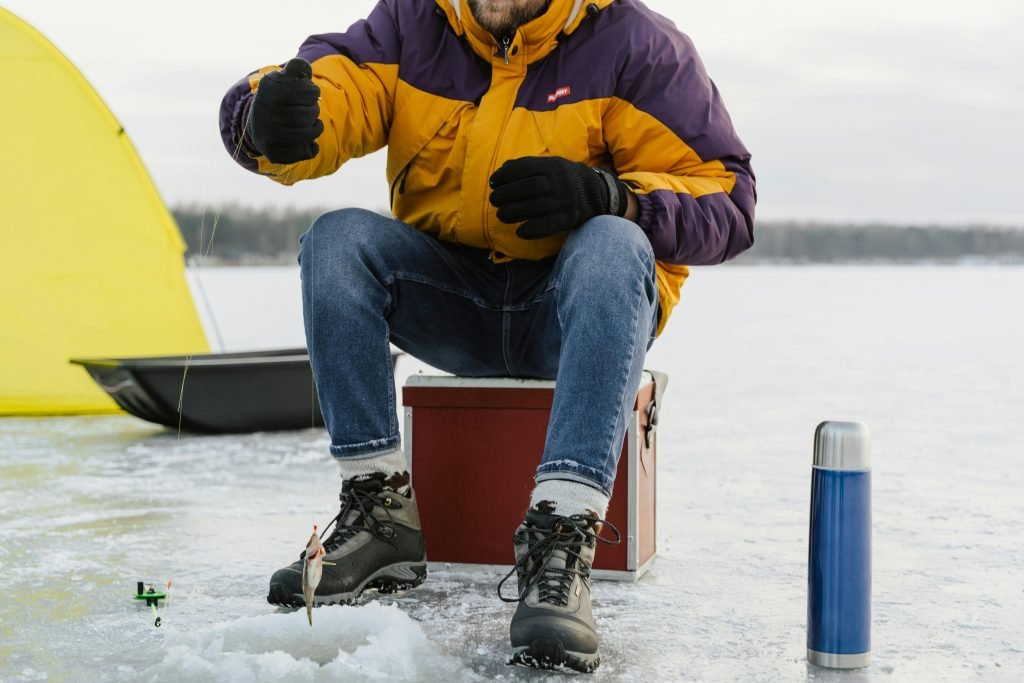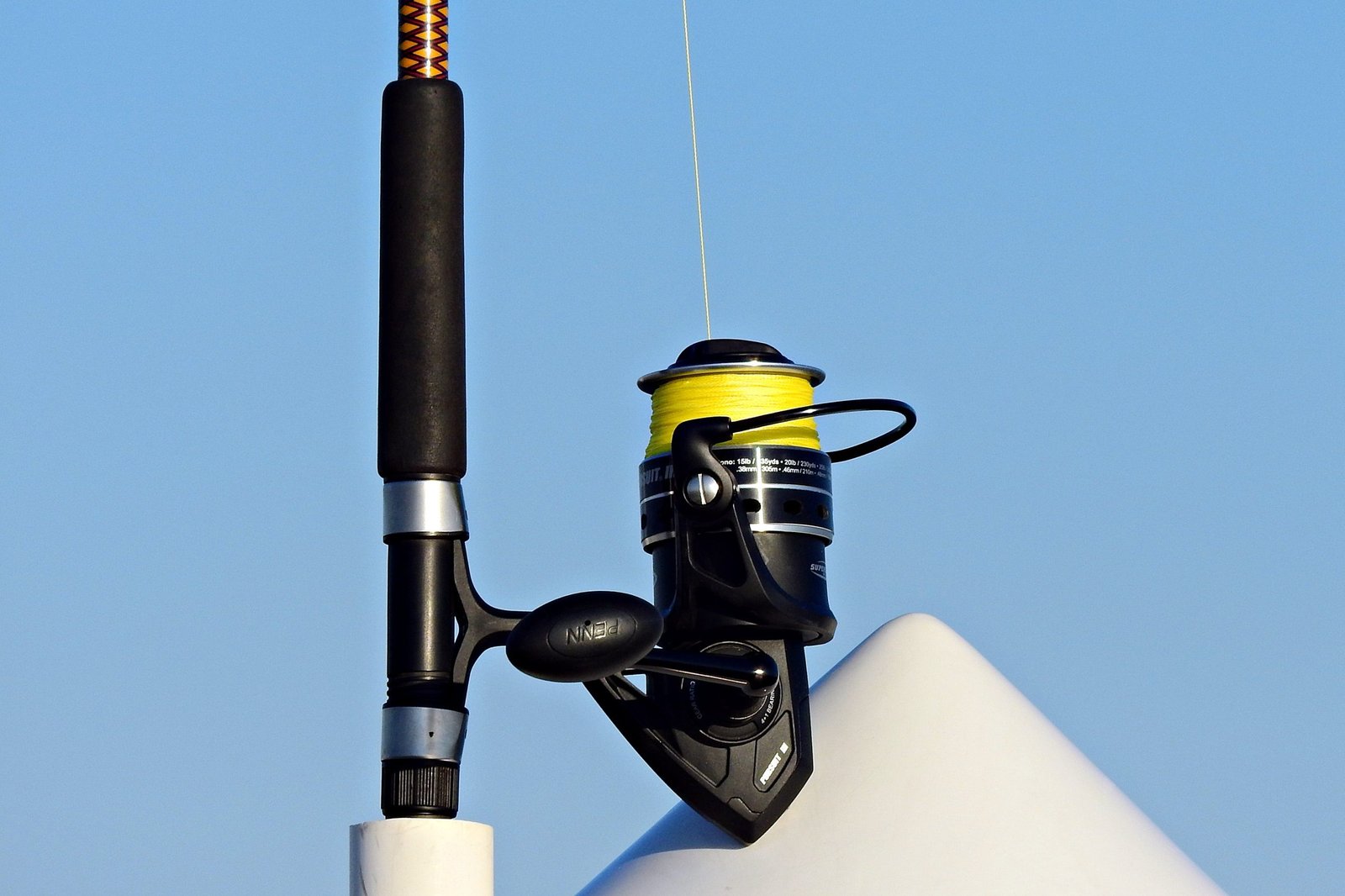
Choosing the best ice fishing line is crucial for a successful day out on the ice. Whether you’re targeting panfish, walleye, or perch, picking the right line can make a big difference. I like using braided lines due to their no-stretch and high sensitivity. They make it easier to detect delicate bites.
You know, it’s a big difference between a coiled line that looks like it could snap at any time and a responsive line that will direct your lure however you want it to move.
When visibility against the icy backdrop is essential, opting for a brightly colored monofilament can help. Mono lines like the a tangerine colored mono are easier to see in snowy conditions, reducing missed catches. This also makes it easier to manage your line and avoid tangles, especially in less-than-ideal light conditions.
Fluorocarbon lines are another popular option, especially for their ability to stay strong even in cold, icy waters. Fluorocarbon lines like Sufix Advance Ice Fluorocarbon offer great abrasion resistance and low visibility, which are perfect for fooling wary fish. If you want to save some money, you can keep it for leaders.
Ice Fishing Line Types
There are three main types of lines to consider: monofilament, fluorocarbon, and braided. Each type has unique features suited for different situations.
Monofilament Lines and Their Characteristics
Monofilament lines are popular due to their versatility and affordability. They are made from a single strand of material, usually nylon. This type of line is known for its stretch, which can be both a benefit and a drawback.
Monofilament is easy to handle and knot. It’s an excellent choice for beginners because it is flexible and forgiving. This line is often less visible in the water, making it a good option for clear ice conditions. It’s also great at absorbing shock, which helps when you’re battling a larger fish under the ice.
Fluorocarbon Lines: Invisible Underwater
Fluorocarbon lines are highly sought after due to their low visibility underwater. These lines are made from a type of material that closely matches the light refraction of water, making them nearly invisible to fish. This feature is crucial when dealing with clear waters and skittish fish.
Another advantage of fluorocarbon lines is their density. They sink faster than monofilament, allowing your bait to reach the desired depth more quickly. Fluorocarbon also offers a higher abrasion resistance, which is beneficial when fishing near structures or sharp ice edges. While they have less stretch, they provide better bite sensitivity, helping you detect even the slightest nibbles.
Braided Lines for Sensitivity and Strength
Braided lines are known for their incredible strength and sensitivity. They are constructed from multiple woven fibers, making them extremely durable with little to no stretch. This lack of stretch means you can feel even the smallest bites, giving you a significant advantage.
Due to their thin diameter, braided lines allow you to pack more line onto your reel. This feature is useful when you need to fish deeper waters. However, they are more visible in water compared to monofilament and fluorocarbon, which might not be ideal in clear conditions. Many anglers prefer to use braided lines with a fluorocarbon leader to combine strength and invisibility.
With these ice fishing line types in mind, you can choose the best option suited for your fishing needs.
Let’s get into the options.
Selecting the Right Line for Your Target Fish

Choosing the right fishing line can greatly improve your success. Different fish have unique behaviors and preferences, so the type of line you use can make a big difference.
Best Lines for Walleye and Pike

Walleye and pike are known for their size and strength. For these fish, braided lines like PowerPro, Spiderwire or Sufix 832 are ideal. Braided lines offer high strength with low diameter, which helps with deep-water fishing and handling strong fish.
Fluorocarbon leaders are a must too. They are more resistant to abrasion, which is helpful when dealing with the teeth and rough mouths of walleye and pike. Seaguar Blue Label is a popular choice for fluorocarbon leaders.
Optimal Choices for Panfish and Trout

Panfish and trout are typically smaller and can be line-shy. Monofilament lines are often the best choice here. Lines like Clam CPT Frost Monofilament offer excellent performance and are gentle enough for delicate presentations.
For small fish like crappie, bluegill, and perch, you may want to opt for 2 to 6-pound test lines. This lighter line increases sensitivity and helps you detect subtle bites, making your fishing much more rewarding.
Handling Hard-Fighting Fish Like Bass

Bass are known for their aggressive behavior and strong fighting abilities. You’ll benefit from using a no-stretch line like Berkley Trilene Micro Ice. These lines give you better hookset performance, which is crucial for keeping bass on your line.
For bass, you’ll often use 8 to 12-pound test lines. This range offers a balance between strength and sensitivity. It’s also beneficial when you’re working with heavier lures and trying to pull bass out from dense cover.
Focus on durability, sensitivity, and strength will help you handle these hard-fighting fish and ensure a successful fishing trip.
From now on, I’ll show you some more about ice fishing lines and how do you shop for them.
Speciality Lines and Innovative Features
Specialty ice fishing lines come with unique features tailored for specific needs, enhancing your fishing experience. Whether you’re looking for tip-ups, leaders, or high-tech innovations, these lines offer solutions to common ice fishing challenges.
Tip-Up Lines: No Memory, No Problem
Tip-up lines are designed to handle extreme conditions with reliability. Low memory and flexibility are key features, reducing the chances of tangles and twist. This means less frustration and more time focused on catching fish.
Tip-ups often use braided lines that remain pliable in frigid temperatures. These lines are a great choice for catching larger fish like pike or walleye. With no coil and high resistance to ice build-up, tip-up lines ensure smooth performance.
Leader Lines: The Strong, Silent Type
Leader lines play an essential role in connecting your main line to your lure. They must be strong, invisible, and resistant to the abrasion common with ice fishing. Fluorocarbon leaders are popular due to their low visibility in water and superior strength.
These lines also have minimal stretch, providing better sensitivity for detecting bites. A good leader line can make a significant difference, especially when pursuing picky feeders like crappie or bluegills.
Innovations: Hydrophobic and Thinner Diameters
Hydrophobic coatings on some ice fishing lines repel water, reducing ice build-up and maintaining a smooth line. This means fewer interruptions and better performance in icy conditions. These lines remain flexible even in cold temperatures, enhancing ease of use.
Additionally, thinner diameter lines are gaining popularity. They offer less resistance in the water, providing better lure action and preventing fish from being spooked. Thinner lines still maintain high strength, making them suitable for various ice fishing scenarios.
By choosing the right specialty lines with innovative features, you can significantly improve your ice fishing success and enjoyment.
Factors Affecting Line Performance
Choosing the best ice fishing line depends on several factors that influence its performance. These include abrasion resistance, water absorption, ice build-up, and visibility.
Abrasion Resistance: Tough as Ice
Abrasion resistance is crucial when fishing through ice. Lines with high abrasion resistance can withstand rough conditions, such as scraping against sharp ice edges. Dyneema fibers are popular for their strong abrasion resistance. They help keep your line intact even when dealing with aggressive fish or fishing in icy environments.
When selecting a line, you should look for ones labeled as “abrasion-resistant”. This feature ensures that your line will last longer and perform well in challenging conditions.
Water Absorption and Ice Build-Up Issues
Water absorption in a fishing line can cause problems like ice build-up, especially in freezing temperatures. Some lines absorb more water, making them prone to freezing and becoming brittle. Fluorocarbon lines are less likely to absorb water, which helps in reducing ice build-up.
To minimize these issues, try using lines designed specifically for ice fishing with coatings that repel water. This helps keep your line flexible and functional in cold weather.
Visibility and Shy Fish: Clear Advantage
Visibility of the fishing line is another factor to consider. Fish can be shy and get scared off by visible lines. Using low-visibility or clear lines can give you a better chance of catching more fish. Fluorocarbon lines are highly effective because they are nearly invisible underwater.
For best results, choose a line with low visibility that blends well with the environment. This makes it less likely for fish to notice your line, increasing your chances of a successful catch.
Ice Fishing Line Shopping Guide

Understanding Pound Test and Line Weight
Pound test indicates the strength of the fishing line. It’s measured by the weight the line can hold before it breaks. For ice fishing, 2-8 pound test lines are common.
Monofilament lines are great for panfish with 2-4 pound tests. For larger fish like walleye, you might want a 6-8 pound test. Heavier tests are stronger but less sensitive, so choose based on the fish you’re targeting.
Line weight also affects how your bait moves. Lighter lines give more natural presentations, crucial in cold water where fish are less active.
Comparing Cost and Value for Money
Fishing lines vary widely in price. Basic monofilament lines are affordable, while specialized lines like fluorocarbon and braided lines cost more.
Monofilament offers good value and versatility but may not be as strong in freezing temperatures. Fluorocarbon is nearly invisible underwater and better for clear ice, though it’s pricier. Braided lines offer superior strength but can be overkill for smaller fish.
Don’t just look at the price—consider how long the line lasts and how well it performs. Spending a bit more initially can save money in the long run.
Key Features for Jigging and Bite Detection
For successful ice fishing, choose lines with good sensitivity and low memory. Sensitivity helps you feel subtle bites, while low memory prevents the line from retaining coils that affect presentation.
Monofilament is easy to handle and works well for jigging if you keep it warm. Fluorocarbon excels in bite detection because it’s sensitive and nearly invisible. Braided lines are excellent for deep water jigging due to their strength and sensitivity, though they may freeze and become less flexible.
Consider lines with a fluorescent coating for better visibility in low-light conditions. This helps you see the slightest movements and improves your reaction time.
Frequently Asked Questions
Ice fishing requires using the right fishing line to improve your chances of success. Different lines have different strengths and properties depending on the fish and conditions.
What type of fishing line should you use for catching walleye under the ice?
For walleye, braided lines like PowerPro Braided Fishing Line are great. They offer strength and sensitivity, making it easier to feel bites and handle larger fish.
Is braided line the superior choice when it comes to ice fishing?
Braided lines are known for their strength and lack of stretch, giving you better sensitivity. However, they can freeze and become stiff in very cold conditions. Consider using a line conditioner to help with this.
What are the benefits of using fluorocarbon line while ice fishing?
Fluorocarbon lines, such as Seaguar Blue Label, are nearly invisible underwater. This can be crucial when fishing in clear ice. They also offer good abrasion resistance and low stretch.
Which fishing line is recommended for use with tip-ups in icy conditions?
A strong monofilament or fluorocarbon line is often recommended for use with tip-ups. Stren Original Monofilament is a good choice due to its versatility and performance in cold temperatures.
How does line color affect visibility and success in ice fishing?
In ice fishing, line color can make a big difference. Clear or light-colored lines like clear monofilament are less visible to fish in clear or slightly cloudy ice. This can lead to more bites and better success.
What strength of fishing line is best suited for targeting panfish in the winter?
For panfish, such as bluegill or crappie, a light line is best. Clam CPT Frost Monofilament with a strength of 2-4 lbs is ideal. This allows for better control and feel, which is important for these smaller fish.




